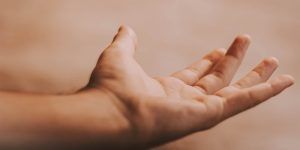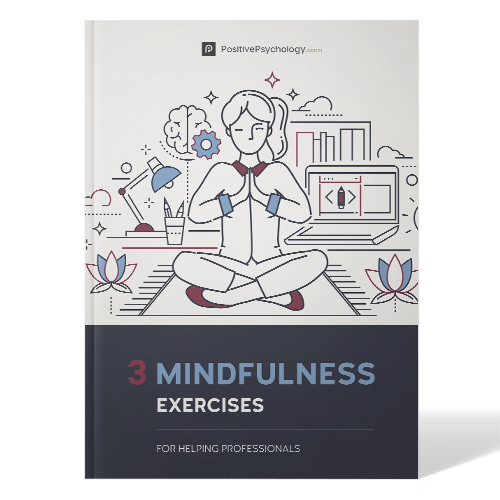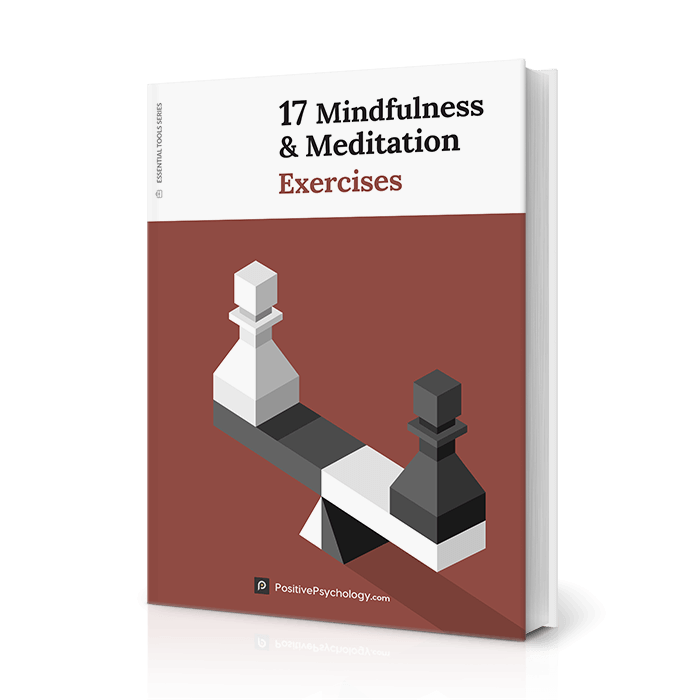How to Perform Body Scan Meditation: 3 Best Scripts
 A body scan meditation is a specific form of mindfulness meditation that requires the practitioner to focus all of their attention on the body.
A body scan meditation is a specific form of mindfulness meditation that requires the practitioner to focus all of their attention on the body.
The mind is guided to focus systematically on various parts of the body, redirecting it back to the practice if you become distracted.
The body scan is a mindfulness-based intervention often used as part of a longer mindfulness-based stress reduction (MBSR) program. However, this meditation can be done as a standalone practice and has many benefits, including deep relaxation, reduced stress and anxiety, and improved sleep (Grossman, Niemann, Schmidt, & Walach, 2004).
This article will detail the history and benefits of this practice and provide scripts and resources for using this tool.
Before you continue, we thought you might like to download our three Mindfulness Exercises for free. These science-based, comprehensive exercises will not only help you cultivate a sense of inner peace throughout your daily life, but also give you the tools to enhance the mindfulness of your clients, students, or employees.
This Article Contains:
What Is Body Scan Meditation in Mindfulness?
The term “body scan” originated with the mindfulness-based stress reduction (MBSR) program introduced by John Kabat-Zinn in the 1970s (Anālayo, 2020).
MBSR is an eight-week program and has enjoyed popularity as an ongoing and successful intervention used in schools and hospitals by teachers and therapists. There is a wealth of research on the program and hundreds of controlled studies demonstrating its effectiveness (Gu, Strauss, Bond, & Cavanagh, 2015).
Although Kabat-Zinn is credited with the success of MBSR and the invention of the body scan meditation as a foundation of the curriculum, the concepts of mindfulness and meditation date back centuries, with their origin in Buddhism.
According to Buddhist scholar Bhikkhu Anālayo (2020), Kabat-Zinn learned meditation from Robert Hover, who taught vipassana meditation retreats in the tradition of U Ba Khin.
U Ba Khin is considered one of the foremost experts in vipassana meditation, teaching the practice in Myanmar and training many teachers who then brought the practice to the West (Vipassana Research Institute, n.d.).
One of the central tenets of vipassana is the recognition of impermanence. It is believed that the acceptance of impermanence can lead to a reduction of suffering. As taught by U Ba Khin, the body scan was a way to meditate on this process.
“In Vipassana the object of meditation is anicca [impermanence], and therefore in the case of those used to focusing their attention on bodily feelings, they can feel anicca directly. In experiencing anicca in relation to the body, it should first be in the area where one can easily get his attention engrossed, changing the area of attention from place to place, from head to feet and from feet to head, at times probing into the interior.”
U Ba Khin, 1997, p. 5–6
Kabat-Zinn’s decision to secularize these meditation practices stemmed from his desire to introduce them as therapies for pain reduction (Helderman, 2019).
MBSR gathers traditions and practices from various Buddhist sources and strips them of their spiritual discourse. In this way, they may be taught in settings like schools and hospitals and enjoyed by people of all walks of life, regardless of their religious affiliations. As such, MBSR is not taught as a Buddhist practice, but rather as a mindfulness-based intervention.
Kabat-Zinn defines mindfulness as paying attention, on purpose, to the present moment, without judgment (Kabat-Zinn & Hahn, 2009). The body scan meditation applies this concept to the body.
The meditator is directed to sweep their attention over the body, resting on various parts of the body systematically. Importantly, there is no direction to change the state of the body; this is not a relaxation exercise. The body scan is merely a mindfulness exercise, designed to bring the mind to rest in the present.
That the body scan does not require the meditator to do anything is an important point that bears repeating. There is a popular technique, known as progressive muscle relaxation (PMR), where the participant is instructed to focus on different parts of the body and then clench and release each muscle. This is a very different practice than the body scan.
Both practices, the body scan and PMR, have a progression of attention over the body, and both practices focus on releasing emotions and judgment of the body. But PMR is an active practice where the participant is working with the body, and eventually the goal is relaxation (Dreeben, Mamberg, & Salmon, 2013).
In contrast, body scan attempts to stay with whatever sensations arise in the body and allow them to come and go on their own (Dreeben et al., 2013).
This level of acceptance is where the power of the body scan lies. This practice has allowed many people to learn to live with chronic pain. The practice can help clients recognize that their pain is not constant but ebbs and flows, and like all things, it is also impermanent.
3 Benefits According to Research

Nervous system response to body scan meditation
Generally, research studies of mindfulness include the entire program (Grossman et al., 2004).
There have been a few studies that attempted to specifically examine the effects of body scan meditation. The purpose of these studies was to clarify the benefits of specific practices within the MBSR model and show the effectiveness of standalone practices.
One such study compared body scan meditations with three conditions: PMR, sitting quietly for 20 minutes, and a control group. They found that after four weeks of a daily 20-minute practice, the group of body scan meditators had a significantly greater increase in parasympathetic activity (Ditto, Eclache, & Goldman, 2006).
When we are stressed and our body is in fight-or-flight mode, this is an activation of the sympathetic nervous system. Ditto et al. (2006) found that regular body scan meditations mediated that response, allowing the participants’ bodies to spend less time in fight or flight (sympathetic) and more time in rest and digest (parasympathetic).
Body scan meditation for managing anxiety
In one study examining the effects of MBSR on mental wellbeing, the researchers could assess the benefits of body scan meditation alone by correlating practice time with outcomes (Carmody & Baer, 2008). They found body scan practice time was positively and significantly correlated with decreased anxiety and increased non-reactivity.
Another study that correlated body scan practice time with outcomes in breast cancer survivors found similar results. Body scan practice time correlated with significant improvements in anxiety, depression, and stress (Lengacher et al., 2009).
Finally, in a study examining the effects of various relaxation techniques during a smoking cessation program, researchers found that participants in the body scan group experienced less irritability, restlessness, and tension while quitting smoking than groups using other relaxation techniques (Ussher, Cropley, Playle, Mohidin, & West, 2009).
Can body scan help with sleep?
Considering the relaxing effects that body scan meditation has shown on the nervous system (Ditto et al., 2006), it is logical to conclude that it would aid in sleep, and research seems to support this conclusion.
One study examined the effects of mindfulness practices as part of a cognitive-behavioral treatment for insomnia (CBTI) in adolescents. Researchers wanted to see if mindfulness practices had any discernible increase in benefit. All the teenagers received CBTI, but only half of the group performed body scan meditations (de Bruin, Meijer, & Bögels, 2020).
Results showed that while all the participants experienced significant improvements in sleep, the body scan group showed better sleep quality and less irritability than the non-meditation group (de Bruin et al., 2020).
Similar to the smoking cessation study, where participants in both groups showed improvements overall, the body scan meditation seems to help with subjective feelings of reactivity, stress, and irritability (de Bruin et al., 2020; Ussher et al., 2009).
Finally, a study in Thailand examined the effects of deep breathing paired with body scan meditations on sleep quality in older adults (Nanthakwang et al., 2020).
Researchers found that outcomes on their sleep quality index increased significantly in the body scan meditation group when compared to a group that listened to music before bed. They also showed that participants’ measures of quality of life improved. This is in line with other results that show that mindfulness-based interventions reduce stress and enhance overall quality of life (Gu et al., 2015).
How to Do Body Scan Meditation
The traditional body scan meditation as taught in MBSR lasts about 30–45 minutes. In this practice, the meditator is lying down. Kabat-Zinn purposely decided to have the practitioner lie down because many of his first patients were in too much pain to complete a 30-minute seated meditation (Anālayo, 2020).
For the complete length of time, the meditator is instructed to maintain awareness of their body. If at any point the awareness shifts away and the participant becomes distracted, they are instructed simply to return to a part of the body and begin again.
The meditation begins at the feet, noticing any sensations present in the toes. Then the meditator slowly moves awareness to the heels, ankles, and upward. The direction is simply to notice and be aware of any sensations that are present.
After moving in this way systematically through the entire body, the meditator is then instructed to link the parts together and feel the body in its entirety.
3 Scripts for Guided Body Scan Meditation

TRY: tuning in to your breath when you find yourself lying down. Feel it moving in your entire body. Dwell with the breath in various regions of your body, such as the feet, the legs, the pelvis and genitals, the belly, the chest, the back, the shoulders, the arms, the throat and neck, the head, the face, the top of your head. Listen carefully. Allow yourself to feel whatever is present. Watch the sensations in the body flux and change. Watch your feelings about them flux and change.
Koru Mindfulness is a mindfulness program created at Duke University for young adults. The program introduces a body scan meditation in the first session. Here is the script from their handbook Mindfulness for the Next Generation (Rogers & Maytan, 2019, p 77–78). For this practice, the meditator is seated.
In our guided meditation today, we’ll be focusing our attention on different body sensations. Today we will use the sensations in our body to help anchor our awareness to our present-moment experience.
You will find that your mind frequently wanders away from your anchor, which is also known as the “object of meditation.” See if you can notice when your mind has wandered and without making judgments about yourself or your ability to do this, gently bring your attention back to the sensations in your body.
It is the nature of the mind to think, and we’re not trying to stop the mind from thinking. We’re just training the mind to focus better by learning to notice when it has wandered away and gently bringing it back, over and over to our present-moment experience.
[pause]
Let’s again get into our meditation position. Let your feet rest on the floor, hands resting in your lap, eyes closed. See if you can keep your spine straight while your muscles relax around it. Listen for the sound of the bell…
[pause]
Let’s begin by bringing our awareness to the bottom of our feet as we notice the feeling of our feet resting against the floor. See if you can just notice the sensations in your feet where they rest against the floor…
[pause]
Now, as you continue to watch the sensations in your feet, allow yourself also to become aware of your breath moving in and out of your body. See if you can imagine your breath moving in and out through the bottom of your feet…
[pause]
With each inhalation, allow your awareness to sharpen; with each exhalation, allow tension and tightness to be released from your feet. Breathing in, focus your attention; breathing out, release tension…
[pause]
(allow a brief period of silence before moving on to the next body part, to allow the students a chance to practice focusing their attention)…
The body scan continues in this way as you move up the body. Adjusting for time as needed, you will usually focus on the thighs, hands, belly, arms, back, shoulders and neck, jaws, muscles around the eyes, and the forehead. This meditation can be lengthened by adding more parts of the body or done fairly briefly by just picking a few.
Of course, the original source of all Buddhist meditation practices are the teachings of the Buddha. There are many texts that describe his teachings, but one that has referenced a practice similar to the body scan is found in the Satipatthana sutta (Anālayo, 2020). This sutta is used by vipassana teachers and considered the first description of sati, or what is now called mindfulness.
The Four Foundations of Mindfulness in Plain English by Bhante Gunaratana (2012) is a wonderful book that outlines this sutta in clear language and guides the reader through several practices.
Gunaratana (2012, p. 58) states that the purpose of meditation on the body is “accepting our body as it is right now, without our usual emotional reactions. It helps us overcome pride and self-hatred and regard our body with the balanced mind of equanimity.”
One body scan meditation outlined in this book considers the “thirty-two parts” of the body. These parts are:
- Twenty parts belonging to the body’s earth element
- Head hairs, body hairs, nails, teeth, skin
- Flesh, sinews, bones, bone marrow, kidneys
- Heart, liver, diaphragm, spleen, lungs
- Large intestines, small intestines, contents of the stomach, feces, brain
- Twelve parts belonging to the body’s water element
- Bile, phlegm, pus, blood, sweat, fat
- Tears, lymph, saliva, mucus, joint fluid, urine
The meditation script continues:
Begin meditating by cultivating loving-friendliness towards all beings. Remind yourself that your intention in meditating on the 32 parts of the body is to overcome pride and self-hatred for your own body and lust and loathing for the bodies of others. You want to regard all bodies and their parts with the balanced mind of equanimity (Gunaratana, 2012, p. 63).
The instructions begin with the first five parts and focus on how changeable they are. For example, the hair on our head is constantly growing, and as we age, it changes texture and color. It is impermanent. The meditator is instructed to focus on these thoughts with each of the parts.
Continue adding each group, meditating on the first 10, then 15, then 20.
Keep in mind that simply repeating the names of the body parts does not do any good. Use your imagination to visualize those parts that are hidden under the skin. Consider each with thoughts similar to those we used for the first five (Gunaratana, 2012, p. 63).
As the meditation continues, more and more parts are added, until the practice includes all 32 parts. Instructions say that the length of time spent on each part and the meditation overall varies. “Some people take longer than others to achieve mindfulness and clear comprehension” (Gunaratana, 2012, p. 64).
Remember that your aim is to recognize that each of the thirty-two parts of the body is impermanent. Because it is subject to growth, decay, disease, and death, it cannot give you lasting satisfaction. Finally, recognize that each is ‘not mind, not I and not my self’ (Gunaratana, 2012, p. 64).
Body Scan Meditation – Jon Kabat-Zinn – Mindfulness 360
4 Helpful Meditation Apps to Download
To take your body scan meditations further, consider installing any one of these meditation apps.
Best overall
Our favorite overall meditation app is Insight Timer.
This meditation app has thousands of free meditations by teachers all over the world. One charming aspect of the app is that when you log in, you can see a map of all the people meditating at the same time as you.
Insight Timer has over 2,000 body scan meditations available. This may seem like an overwhelming number, but you can narrow your search by the length of the meditation and other filters. There are body scan meditations that last anywhere from 5 to 45 minutes.
Best for beginners

It is a great app for beginners because unlike Insight Timer, it can lead the user through one clear course. Their 10-day beginner course is free and has helped many to get started on the path of meditating every day.
Best for sleep

The app contains many relaxing meditations, as well as sleep stories and relaxing soundscapes. There are a handful of body scan meditations. In order to have access to all the meditations, a subscription is required.
Best for mood

Then it will give recommended activities based on your response. It’s an intuitive app that allows users to set goals based around reducing anxiety or stress, improving sleep, and other wellness objectives. This app has many free meditations as well as a monthly subscription to access all the benefits.
Resources From PositivePsychology.com
PositivePsychology.com has many other blog posts on the benefits of mindfulness. If you’d like to learn more about the general practice, here are excellent places to start:
- 23 Amazing Health Benefits of Mindfulness for Body and Brain
- What Is Meditation Therapy and What Are the Benefits?
- The Importance of Mindfulness: 20+ Reasons to Practice Mindfulness
- 3 Simple Guided Meditation Scripts for Improving Wellbeing
In addition to great mindfulness articles, we also have many worksheets to help coaches and therapists incorporate mindfulness into their practice. Here are two good introductory worksheets:
3 Steps to cultivate mindful awareness
This worksheet gives the reader a brief mindfulness exercise to practice when time is limited. It is also an excellent tool for those brand new to mindfulness.
The three-step process helps you to return to the present quickly, which can reduce acute stress in the moment and, when done regularly, reduce overall stress and anxiety.
Right Here, Right Now
This is a brief and simple exercise that will guide you into the present. The worksheet asks us to name what we can see, hear, feel, smell, and touch right now. This exercise is excellent for children and adults alike and can foster a feeling of groundedness.
Toolkit tools
Our Positive Psychology Toolkit© contains hundreds of useful resources for practitioners. One of the activities includes a lesson for leading clients in a body scan meditation.
The toolkit provides both a PDF of the script as well as a 20-minute audio meditation that leads you through the body scan. It begins by asking the listener to lie down and close their eyes. Then, similar to the scripts above, it takes a gradual approach, inviting the listener to breathe into each body part and attend to each sensation without judgment.
Because this tool is designed with practitioners in mind, there is also advice on how to lead clients through a body scan. Some reminders include letting go of judgment around how successful you are at staying present and releasing the goal of not getting distracted.
17 Mindfulness & meditation exercises
If you’re looking for more science-based ways to help others enjoy the benefits of mindfulness, check out this collection of 17 validated mindfulness tools for practitioners. Use them to help others reduce stress and create positive shifts in their mental, physical, and emotional health.
A Take-Home Message
Mindfulness meditation is an incredible tool for increasing mental and physical health (Carmody & Baer, 2008). Body scan meditations are a simple and effective way to begin learning mindfulness meditation.
Introducing mindfulness through a body scan meditation can help those new to meditation by giving them a familiar object to focus their attention on.
Body scan meditation, whether alone or part of a longer mindfulness course, can help calm the nervous system, reduce stress and anxiety, and improve sleep (de Bruin et al., 2020; Ditto et al., 2006; Nanthakwang et al., 2020).
If you’d like to develop your self-compassion and release judgment about your body, or if you would just like to reduce the effects of stress, try a body scan meditation. Research has shown the incredible benefits; try it for yourself.
We hope you enjoyed reading this article. Don’t forget to download our three Mindfulness Exercises for free.
- Anālayo, B. (2020). Buddhist antecedents to the body scan meditation. Mindfulness, 11, 194–202.
- Carmody, J., & Baer, R. A. (2008). Relationships between mindfulness practice and levels of mindfulness, medical and psychological symptoms and well-being in a mindfulness-based stress reduction program. Journal of Behavioral Medicine, 31(1), 23–33.
- De Bruin, E. J., Meijer, A., & Bögels, S. M. (2020). The contribution of a body scan mindfulness meditation to effectiveness of Internet-delivered CBT for insomnia in adolescents. Mindfulness, 11(4), 872–882.
- Ditto, B., Eclache, M., & Goldman, N. (2006). Short-term autonomic and cardiovascular effects of mindfulness body scan meditation. Annals of Behavioral Medicine, 32(3), 227–234.
- Dreeben, S. J., Mamberg, M. H., & Salmon, P. (2013). The MBSR body scan in clinical practice. Mindfulness, 4(4), 394–401.
- Grossman, P., Niemann, L., Schmidt, S., & Walach, H. (2004). Mindfulness-based stress reduction and health benefits: A meta-analysis. Journal of Psychosomatic Research, 57(1), 35–43.
- Gu, J., Strauss, C., Bond, R., & Cavanagh, K. (2015). How do mindfulness-based cognitive therapy and mindfulness-based stress reduction improve mental health and wellbeing? A systematic review and meta-analysis of meditation studies. Clinical Psychology Review, 37, 1–12.
- Gunaratana, H. (2012). The four foundations of mindfulness in plain English. Simon and Schuster.
- Helderman, I. (2019). Prescribing the dharma: Psychotherapists, Buddhist traditions, and defining religion. UNC Press Books.
- Kabat-Zinn, J. (2009). Wherever you go, there you are: Mindfulness meditation in everyday life. Hachette Books.
- Kabat-Zinn, J., & Hanh, T. N. (2009). Full catastrophe living: Using the wisdom of your body and mind to face stress, pain, and illness. Delta.
- Lengacher, C. A., Johnson-Mallard, V., Post-White, J., Moscoso, M. S., Jacobsen, P. B., Klein, T. W., … Kip, K. E. (2009). Randomized controlled trial of mindfulness-based stress reduction (MBSR) for survivors of breast cancer. Psycho-Oncology, 18(12), 1261–1272.
- Nanthakwang, N., Siviroj, P., Matanasarawoot, A., Sapbamrer, R., Lerttrakarnnon, P., & Awiphan, R. (2020). Effectiveness of deep breathing and body scan meditation combined with music to improve sleep quality and quality of life in older adults. The Open Public Health Journal, 13(1).
- Rogers, H., & Maytan, M. (2019). Mindfulness for the next generation: Helping emerging adults manage stress and lead healthier lives (2nd ed.). Oxford University Press.
- U Ba Khin, S. (1997). The essentials of Buddha-Dhamma in meditative practice. Pariyatti.
- Ussher, M., Cropley, M., Playle, S., Mohidin, R., & West, R. (2009). Effect of isometric exercise and body scanning on cigarette cravings and withdrawal symptoms. Addiction, 104, 1251–1257.
- Vipassana Research Institute. (n.d.) Sagyagyi U Ba Khin. Retrieved November 18, 2021, from https://www.vridhamma.org/Sayagyi-U-Ba-Khin
Read other articles by their category
- Body & Brain (49)
- Coaching & Application (57)
- Compassion (26)
- Counseling (51)
- Emotional Intelligence (24)
- Gratitude (18)
- Grief & Bereavement (21)
- Happiness & SWB (40)
- Meaning & Values (26)
- Meditation (20)
- Mindfulness (45)
- Motivation & Goals (45)
- Optimism & Mindset (34)
- Positive CBT (28)
- Positive Communication (20)
- Positive Education (47)
- Positive Emotions (32)
- Positive Leadership (18)
- Positive Parenting (4)
- Positive Psychology (33)
- Positive Workplace (37)
- Productivity (16)
- Relationships (46)
- Resilience & Coping (36)
- Self Awareness (21)
- Self Esteem (37)
- Strengths & Virtues (31)
- Stress & Burnout Prevention (34)
- Theory & Books (46)
- Therapy Exercises (37)
- Types of Therapy (64)




